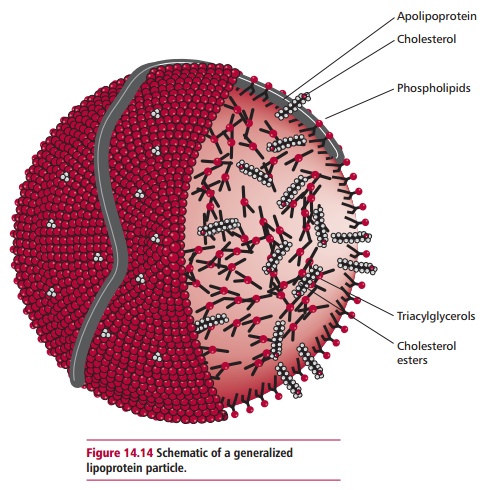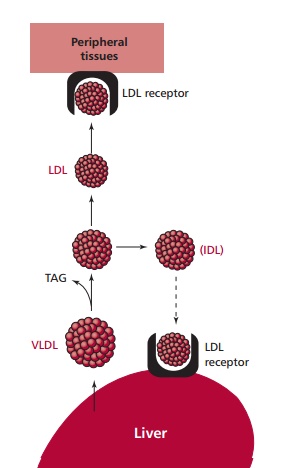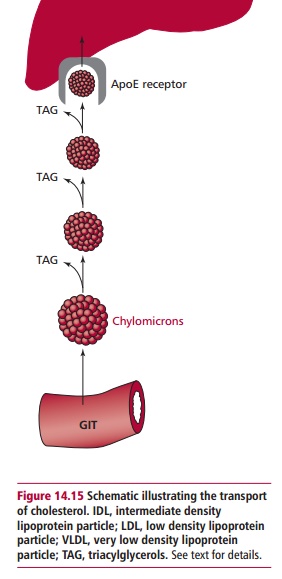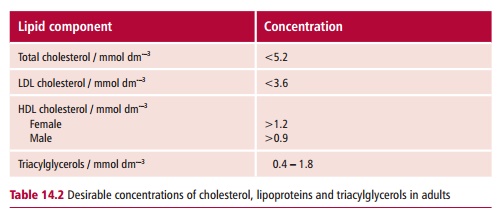Chapter: Biology of Disease: Disorders of the Cardiovascular System
Cholesterol and Lipoproteins
CHOLESTEROL AND LIPOPROTEINS
Aside from any inherited tendency to develop hypertension, there are a number of nongenetic factors that correlate with an increased risk of cardiovascular disease. These include smoking, lack of exercise, a diet containing too much and inappropriate fat types ; all lead to an abnormal concentration of cholesterol in the blood. Homocysteine is known to be raised in certain genetic conditions and coronary heart disease and is suspected to have a role in increasing cholesterol levels. Homocysteine concentrations can be lowered by treatments with folate and vitamin B12 with a subsequent reduction in blood cholesterol.
Cholesterol is essential because it forms part of the plasma membrane of cells and is used in the biosynthesis of bile salts and steroid hormones. However, atherosclerosis is largely due to problems with cholesterol. The body can synthesize it but it is also obtained from the diet. Cholesterol is practically insoluble in plasma and, like triacylglycerols, is transported in the blood in lipoprotein particles. It is an imbalance between the different types of lipoprotein particles that leads to clinical problems.

Plasma lipoprotein particles consist of a core of triacylglycerols and cholesterol esters surrounded by phospholipids, proteins and free cholesterol (Figure14.14). They are classified by their densities, the greater the proportion oftriacylglycerol the lower the density (Table 14.1). There are several different types of lipoproteins in lipoprotein particles, called apolipoprotein-A and –B, -C, -D and -E, usually abbreviated to apoA, apoB, apoC, apoD and apoE.

The transport of cholesterol round the body is a complicated process (Figure14.15). There is some cholesterol in the chylomicrons derived from the diet,but the liver exports the cholesterol obtained from the diet or synthesized, together with triacylglycerols it synthesized from dietary carbohydrate,


in the form of very low density lipoproteins (VLDL). These contain the apolipoprotein, B-100, but the major lipids are triacylglycerols, with less than 20% free cholesterol and cholesteryl esters (Table 14.1). A primary determinant of the amount of VLDL secreted is the amount of free fatty acids entering the liver. Further, if saturated fatty acids predominate, the VLDL particles are smaller but more numerous than if polyunsaturated fatty acids are in excess. A high carbohydrate diet also substantially increases the concentration of plasma VLDL particles. Newly secreted VLDL particles undergo a series of changes in the plasma. They acquire apoC and apoE proteins from high density lipoproteins (HDL, see below). The catalyzed hydrolysis of triacylglycerols by lipoprotein lipase of the endothelial cells of capillaries allows the fatty acids and glycerol to be taken up by tissues. The reduced triacylglycerol content increases the density of the VLDL so that they become low density lipoproteins (LDL), and these particles are the principal carriers of cholesterol in the plasma. Low density lipoprotein particles serve as the major source of cholesterol for most of the tissues. Although most cells can synthesize cholesterol, the bulk of synthesis occurs in the liver and intestinal enterocytes.
The concentration of LDL in the plasma correlates positively with the incidence of coronary heart disease. Hence LDL is often referred to as ‘bad’ cholesterol. However, it is only ‘bad’ in excess, and when combined with other risk factors. High density lipoproteins are secreted by the liver, but they are also formed by modifications to chylomicrons and VLDL. High density lipoproteins (Table 14.1) can pick up cholesterol from tissues, essentially the opposite function to that of LDL. The particles probably acquire cholesterol from the cell surface membranes and convert it enzymatically to cholesteryl esters. Consequently HDL may be considered ‘good’ cholesterol.
Measuring serum cholesterol
It is necessary to know the concentration of LDL cholesterol in serum (Table14.2) to assess risks to a person, diagnose an ailment and monitor the progressof a patient. However, until recently this could only be determined by a rather complicated laboratory technique not available for routine clinical use. An empirical formula (the Friedewald Formula) was used to derive the LDL cholesterol concentration from the HDL cholesterol and the triacylglycerol levels. However, this formula is inaccurate and sometime fails completely, such as when serum triacylglycerol concentrations are high. A newer test is the LDL Direct method that isolates LDL cholesterol using an immunological assay. It is more accurate, does not require the patient to fast and is not affected by high concentrations of triacylglycerols in the serum.

Familial hypercholesterolemia
The circulating LDL particles are recognized by protein receptors on the surfaces of liver cells and removed from the plasma by endocytosis into the cells. Here their various components are metabolized, stored or recycled. The disease, familial hypercholesterolemia, is an autosomal dominant condition that affects heterozygotes, with a frequency of one in 500. It is associated with a defective receptor on the liver cells. This disease has been intensively investigated and a great deal is known about it. For the sufferers, the problems are whitish-yellow deposits largely of cholesterol on the tendons called xanthomas, and opaque fatty deposits around the periphery of the cornea called corneal arcuses and an onset of coronary heart disease before the age of 10 years in homozygotes. The blood cholesterol concentrations in homozygotes are between 15 and 30 mmol dm–3 compared with normal values of about 5.0.
Related Topics